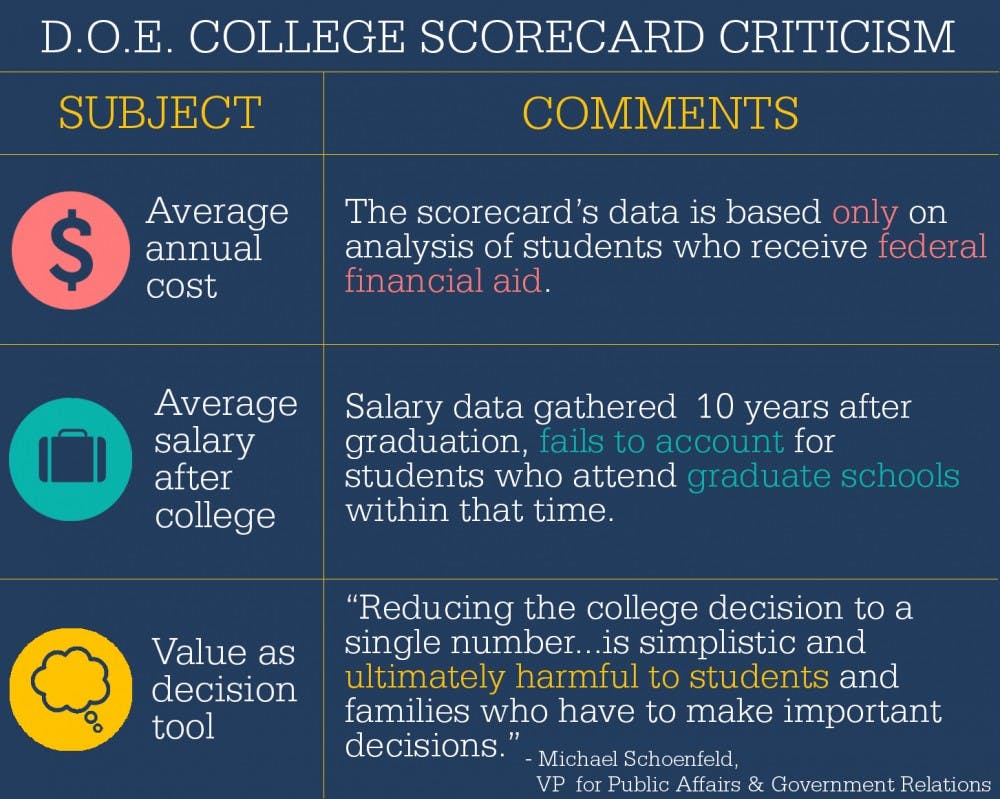The Department of Education’s newly released College Scorecard contains a wealth of information about universities nationwide, but Duke administrators and students have been quick to point out its shortcomings.
The College Scorecard, unveiled earlier this month, provides data on a number of categories and allows for colleges to be sorted and compared. Duke performs better than the national average in almost all of the Scorecard’s categories, which include percentage of students paying off their debt, graduation and retention rates and average salary after attending. The only category in which Duke fares worse is average annual cost, in which the University exceeds the national average by $11,269. According to the data, Duke has an average annual cost of $28,058, a graduation rate of 94 percent and an average salary after attending of $76,700.
“More information is better than less information when it comes to making college choices, so the new government database is a useful addition,” said Michael Schoenfeld, vice president for public affairs and government relations.
Schoenfeld, however, was skeptical of the idea that prospective students should rely on the Scorecard.
“Reducing the college decision to a single number—whether a U.S. News ranking or earnings 10 years out—is simplistic and ultimately harmful to students and families who have to make important decisions,” he said.
The Scorecard is also missing key data, Schoenfeld said. The data is based only on an analysis of students who receive federal financial aid, he explained, which may skew the data.
Students have noticed that the Scorecard, though it emphasizes the economic returns from a college education, fails to present contributing factors behind many of the numbers. For example, many schools with high alumni earnings are engineering or business schools, which is irrelevant to students who are not interested in going into those fields.
“While it has some good information, and it’s nice that some places have high salaries, I think it’d be better to find the salary that corresponded to the major or career path you’re interested in,” said freshman Alexandra Uribe.
Uribe added that she would probably use the Scorecard “about equally or less” than other rankings available, such as the annual list published by U.S. News and World Report.
The Scorecard overlooks the many different career paths students can take, Schoenfeld said. Salary data is gathered 10 years after graduation, thus failing to account for students who attend medical, law or business schools within 10 years of graduating. This may lead to a lower average salary figure even though those students were not actively seeking jobs upon graduation, he explained. Some Duke students also questioned the validity of placing so much emphasis on postgraduate earnings.
“If income earnings are that significant of a factor in rankings, why aren’t we ranking associate degree programs or trade schools?” asked junior Conrad Jeong. “We’re pushing this paradoxical narrative of ‘if you don’t go to a four-year college, you’re dumb, but if you don’t make money after graduating from a four-year college, you’re still dumb’—which doesn’t really make sense, considering how many different pathways there are to making money.”
The College Scorecard also points out the high tuition of private universities. Duke’s $6,280 average tuition for students on financial aid is considerably higher than many of its counterparts—including Columbia University at $5,497, Harvard University at $3,386 and Stanford University at $3,895.
“Colleges primarily serve as places to become educated and learn to think critically about the world around them,” Jeong said. “Of course, that can’t happen when 20-year-olds go into debt for the rest of their lives trying to become more educated.”

